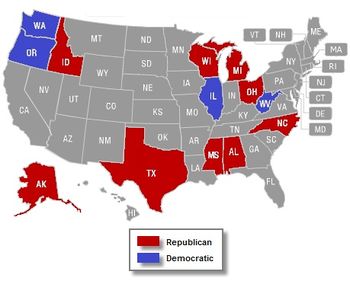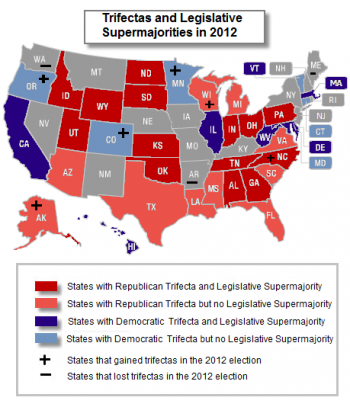It’s the 12 Days of Ballotpedia! Your gift powers the trusted, unbiased information voters need heading into 2026. Donate now!
State government trifecta analysis, 2014
State party control after the November 2014 elections
The following table details the partisan status for state government offices in all 50 states following the 2014 election. Cells are colored based on which party controls the chamber or office. In seven states, Democrats hold both legislative chambers as well as the governor's office, while Republicans have the same advantage in 24 states. Nebraska's governor is a Republican and the legislature, although technically nonpartisan, is controlled by a Republican majority.[1]
| State | Governor | Gubernatorial Party | Democratic Senators | Republican Senators | Other Party Senator | Senate Vacancy | Democratic House Member | Republican House Member | Other Party House Member | House Vacancy | |
| Alabama | Robert J. Bentley | Republican | 8 | 26 | - | 33 | 72 | - | |||
| Alaska | Bill Walker | Independent | 6 | 14 | - | 16 | 23 | 1 | |||
| Arizona | Doug Ducey | Republican | 13 | 17 | - | 22 | 38 | - | |||
| Arkansas | Asa Hutchinson | Republican | 11 | 24 | - | 36 | 64 | - | |||
| California | Jerry Brown | Democratic | 25 | 14 | - | 1 | 52 | 28 | - | ||
| Colorado | John Hickenlooper | Democratic | 17 | 18 | - | 34 | 31 | - | |||
| Connecticut | Dan Malloy | Democratic | 21 | 15 | - | 87 | 64 | - | |||
| Delaware | Jack Markell | Democratic | 12 | 9 | - | 25 | 16 | - | |||
| Florida | Rick Scott | Republican | 14 | 26 | - | 37 | 82 | - | 1 | ||
| Georgia | Nathan Deal | Republican | 18 | 38 | - | 59 | 120 | 1 | |||
| Hawaii | David Ige | Democratic | 24 | 1 | - | 43 | 8 | - | |||
| Idaho | Butch Otter | Republican | 7 | 28 | - | 14 | 56 | - | |||
| Illinois | Bruce Rauner | Republican | 39 | 20 | - | 71 | 47 | - | |||
| Indiana | Mike Pence | Republican | 10 | 40 | - | 29 | 71 | - | |||
| Iowa | Terry E. Branstad | Republican | 26 | 24 | - | 43 | 57 | - | |||
| Kansas | Sam Brownback | Republican | 8 | 32 | - | 28 | 97 | - | |||
| Kentucky | Steve Beshear | Democratic | 12 | 26 | - | 54 | 46 | - | |||
| Louisiana | Bobby Jindal | Republican | 13 | 26 | - | 43 | 59 | 2 | 1 | ||
| Maine | Paul LePage | Republican | 15 | 20 | - | 79 | 68 | 4 | 2 | ||
| Maryland | Larry Hogan | Republican | 33 | 14 | - | 90 | 51 | - | |||
| Massachusetts | Charles D. Baker | Republican | 34 | 6 | - | 126 | 34 | - | |||
| Michigan | Rick Snyder | Republican | 11 | 27 | - | 47 | 63 | - | |||
| Minnesota | Mark Dayton | Democratic | 39 | 28 | - | 62 | 72 | - | |||
| Mississippi | Phil Bryant | Republican | 20 | 32 | - | 58 | 64 | - | |||
| Missouri | Jay Nixon | Democratic | 9 | 25 | - | 45 | 117 | - | 1 | ||
| Montana | Steve Bullock | Democratic | 21 | 29 | - | 41 | 59 | - | 1 | ||
| Nebraska | Pete Ricketts | Republican | 11 | 36 | 1 | 1 | |||||
| Nevada | Brian Sandoval | Republican | 10 | 11 | - | 15 | 27 | - | |||
| New Hampshire | Maggie Hassan | Democratic | 10 | 14 | - | 160 | 239 | 1 | |||
| New Jersey | Chris Christie | Republican | 24 | 16 | - | 45 | 32 | - | 3 | ||
| New Mexico | Susana Martinez | Republican | 25 | 17 | - | 33 | 37 | - | |||
| New York | Andrew Cuomo | Democratic | 31 | 32 | - | 106 | 44 | - | |||
| North Carolina | Pat McCrory | Republican | 16 | 34 | - | 46 | 74 | - | |||
| North Dakota | Jack Dalrymple | Republican | 15 | 32 | - | 23 | 71 | - | |||
| Ohio | John Kasich | Republican | 10 | 23 | - | 34 | 65 | - | |||
| Oklahoma | Mary Fallin | Republican | 8 | 40 | - | 29 | 72 | - | |||
| Oregon | John Kitzhaber | Democratic | 18 | 12 | - | 35 | 25 | - | |||
| Pennsylvania | Tom Wolf | Democratic | 30 | 20 | - | 84 | 119 | - | |||
| Rhode Island | Gina Raimondo | Democratic | 32 | 5 | 1 | 63 | 11 | 1 | |||
| South Carolina | Nikki Haley | Republican | 18 | 28 | - | 46 | 77 | - | 1 | ||
| South Dakota | Dennis Daugaard | Republican | 8 | 27 | - | 12 | 58 | - | |||
| Tennessee | Bill Haslam | Republican | 6 | 27 | - | 26 | 73 | - | |||
| Texas | Greg Abbott | Republican | 11 | 20 | - | 52 | 98 | - | |||
| Utah | Gary Herbert | Republican | 4 | 23 | - | 2 | 13 | 62 | - | ||
| Vermont | Peter Shumlin | Democratic | 20 | 9 | 1 | 85 | 53 | 6 | 6 | ||
| Virginia | Terry McAuliffe | Democratic | 19 | 21 | - | 32 | 67 | 1 | |||
| Washington | Jay Inslee | Democratic | 24 | 25 | - | 2 | 50 | 47 | - | 1 | |
| West Virginia | Earl Ray Tomblin | Democratic | 16 | 18 | - | 36 | 64 | - | |||
| Wisconsin | Scott Walker | Republican | 14 | 19 | - | 36 | 63 | - | |||
| Wyoming | Matt Mead | Republican | 4 | 26 | - | 9 | 51 | - |
Trifecta variations
Trifecta plus
Trifectas can be further analyzed by adding in an additional dataset -- State Supreme Courts. In some states, state supreme court justices are elected on a partisan ticket, while in some cases elected justices are nonpartisan. Still in other states, the justices are appointed. However, in many cases, there is an effective understanding that a working majority of the court sides with either conservative or progressive issues.
A Trifecta Plus for the Democratic Party is a state with a Trifecta and a working majority of the state's high court that tends to support progressive jurisprudence. A Trifecta Plus for the Republican Party is a state with a Trifecta and a working majority of the state's high court that tends to support conservative/libertarian jurisprudence.
A 2014 analysis by the Democratic Judicial Campaign Committee found 22 states where the state supreme court could be labeled as leaning liberal or conservative.[2] Incorporating the trifecta data, the following is a breakdown of the states with a Trifecta Plus in September 2014:
Trifectas and supermajorities
In addition to having a trifecta, it is also worth exploring which states have supermajorities. The supermajority allows a party in power to further exert its influence over the minority party.
In August 2013, there were 23 states with a trifecta and a supermajority and 14 states with a trifecta but no legislative supermajority. The breakdown was as follows:[3]
|
Democratic trifectas and supermajorities (8) |
Republican trifectas and supermajorities (15) |
- Note: In early 2013, two states were added to the supermajority with trifecta count. In Louisiana, a state senator switched to the GOP, providing a supermajority for Republicans. In Rhode Island, Governor Lincoln Chafee switched from Independent to Democratic, providing a trifecta to the Democrats to go along with an existing legislative supermajority.
Visualizations
Ballotpedia has tracked the party control of state government, going back to 1992. Click on show on the charts and infographics below to see how state partisan control has evolved in the recent past:
Visualization of state party control
Figure 10: Visualization of Trifectas from 1992-2013 -- Alabama-Missouri

Figure 11: Visualization of Trifectas from 1992-2013 -- Montana-Wyoming
Trifectas and presidential voting
Figure 19: Visualization of State Partisanship (with Presidential voting) from 1992-2013 -- Alabama-Missouri
Figure 20: Visualization of State Partisanship (with Presidential voting) from 1992-2013 -- Montana-Wyoming
Infographic of state government partisanship
| Infographic of Partisanship Results | |||||
|---|---|---|---|---|---|
 This infographic was created by Attwood Digital | |||||
See also
- Partisan composition of state senates
- Partisan composition of state houses
- Governor
- State executive offices
- State government trifectas
- Ballotpedia:Who Runs the States
- Ballotpedia:Who Runs the States, Partisanship Results, State Government Trifectas
- Democratic and Republican state government trifectas heading into the 2012 elections
Footnotes
- ↑ Omaha.com, "Democrats cut into GOP lead in Nebraska Legislature," accessed May 13, 2014 (dead link)
- ↑ Democratic Judicial Campaign Committee, "Judicial Landscape," accessed September 2014
- ↑ NCSL "Half the States will Have Veto-Proof Majorities," November 27, 2012
- ↑ Note: While Pennsylvania does not have an actual supermajority, it is included in this list because only a simple majority is required to override a governor's veto. Therefore, the powers of a supermajority are present in Pennsylvania, and thus it is included here.
| ||||||||||||||||||||||||||||||||||










